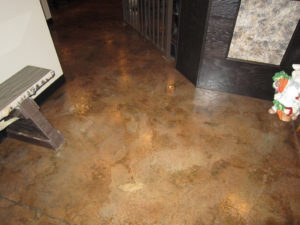The ABCs of Choosing The Right Stained Concrete For Your Home
Choosing the right concrete stain to use on your home can be confusing, but it doesn't have to be if you know what to look for when shopping for stains. Many different stains are available on the market today, but homeowners should know that not all stains are alike.
In this blog post, we'll go over some basic information about various types of concrete floor stains and talk through some pros and cons so that you can make an informed decision before starting any decorative project on your property.
Different types of stains are available today
There are many different styles of stains available on the market today, including water-based stains, acid-based stains, solvents, and oil-based stains. Some are more expensive than others, but the price typically depends on the quality of the color rather than the brand name.
-
Water-based stains
Water-based stains are the best option for san Diego homeowners who don't want to deal with the hassle and cost. Water-based stains require little to no scrubbing and can be cleaned up right away with water.
-
Oil-based stains
Oil-based stains are the most high-priced type of stain available on the market today. They offer excellent coverage, but San Diego homeowners should know that oil-based stains are difficult to remove if not applied properly. Most homeowners do not recommend this type of stain unless they have used it on the same concrete surfaces.
-
Acid-based stains
Acid-based stains offer excellent coverage but can also be expensive. They must be applied by experienced contractors and require both water and acid during the cleaning process.
-
Solvent-based stains
Solvent-based stains are very high in price, but they offer excellent coverage and great color selection options that are not available with any other type of concrete staining. It is tough to remove solvent-based stains if they are not applied or cleaned correctly after staining.
Factors to consider in choosing a concrete staining
There are many factors to consider when selecting decorative concrete stains for your home. Although concrete can come in various colors, it is essential to remember that all concrete isn't the same; different types of concrete absorb stains differently. Some will require additional steps or products to help the stain penetrate the pores.
The ABCs below can help you in choosing the proper concrete staining for your home.
A is for aggregate: If you want a uniform color throughout your concrete, choose an acid-based stain that will react with and alter the surface of the aggregates (rocks) - it changes the composition of chemicals of the cement paste.
B is for bleed water: If your concrete is viewed from a distance, you want to make sure that the bleed water (water trapped within the pores of concrete) rises to the surface after your concrete has been wet down with a hose or from rain. This means that the dye in the stain has been able to penetrate the pores of your decorative concrete, and you will get the maximum color depth possible.
C is for curing: If your concrete floors have not cured correctly (typically 28 days), it may be more challenging for the stain to penetrate specific areas of your home - which means that some sections may appear darker than others. Even though new technologies help speed up the curing process, give your concrete floors at least 28 days before applying the San Diego decorative concrete stain.
D is for dye: Two types of dyes can be used in an acid-based concrete stain - dispersant and nonexpansive dyes. Dispersant dyes are the most commonly used, and they allow the decorative concrete to retain its original texture. In other words, it won't look as though you have a stain on your concrete - just a great-looking new color! This type of dye will do an excellent job of penetrating the pores of the concrete.
E is for expansion: Expansion dyes are Non expansive dyes, so they will not allow the concrete to retain its original texture. It is important to note that these dyes will not penetrate the pores of your concrete.
Therefore, it may be necessary to use an acid-based stain remover or a concrete grinder with an etching product/concrete cleaner to remove the top layer of concrete and create a rough surface. The dye can then be applied directly onto this more unpolished concrete, which will allow it to absorb into the pores more effectively.
F is for fading: If you want a more subtle look on your home's exterior, like patios and other outdoor surfaces, choose a water-based concrete stain. These stains will not penetrate the pores, so they will sit on top of the concrete and prevent water from evaporating. Therefore, the color will fade over time so that your home's exterior looks excellent year-round without having to reapply for a new coat every few weeks.
G is for grout lines: There are three different types of stains to consider when applying them over your home's grout lines. If you want the appearance of grout lines with a water-based stain, apply it over your home's grout using a sponge. If you want a more subtle look, consider a diffusive stain or penetrating stain.
These do not contain a dye, so they will not absorb into the pores. Therefore, more of a color will be deposited onto your home's grout lines. If you want to have an excessively bold grout line, consider using a transparent penetrating stain.
H is for haze: If you are re-staining your home's exterior, you want to make sure that the new coat is applied in a thin layer. You do not want to use too much of the product in one area because it will create a hazy appearance where the new concrete staining has been applied.
I for intermixing: If you apply an acid-based concrete stain, there should not be any combining between different products. For example, if you use an acid-based concrete stain and then decide to go with an oil-based stain, you should not apply both simultaneously.
You will need to wait until after the acid-based product has dried to apply the oil-based stain. If you want to switch from an acid-based concrete stain to a water-based concrete stain, you should use the water-based product first. Then, after it has dried, you can go back over it with an oil-based product if desired.
J is for joints: You can either choose to use an acid-based concrete stain or a water-based concrete stain, depending on what you want your home's joints to look like. The acid-based staining will be absorbed into the pores of the concrete, which will give you a very subtle and natural appearance. The water-based staining will sit on top of the concrete and dry, so it may not show you the natural appearance that you desire.
What kind of sealer is needed?
It's always a good idea to get a sealant along with whatever type of staining you choose for your home's concrete. It's crucial because the concrete must be cleaned first, and other than water-based stains, all different types of stains need a sealant.
Do you want a more natural look?
Some staining will alter the color of the concrete, while others, such as dyes, penetrol, and pigment, will not. Choosing a hue for stains that change colors can be challenging because you'll want to avoid causing your concrete to stain in a tone different from what you intended.
Conclusion
With so many different brands and styles of concrete staining on the market, it can seem challenging to choose just one. You can simplify this decision by narrowing down what type of stain you need for your home's particular needs.
We hope this article has given you some valuable insights into what factors to consider when shopping around.
If you're still unsure about the correct type of stain for your needs, please give San Diego Stamped Concrete a call! Our expert concrete contractors can help guide you through our wide selection of stains and make recommendations that fit with both your budget and design goals.
Service Region
Greater San Diego, CA | Chula Vista, CA | El Cajon, CA | La Mesa, CA | And Beyond!



